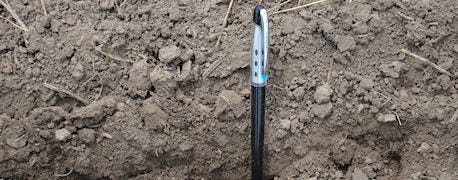
Anecdotal evidence and some research studies in Indiana recently have pointed to planting corn deeper rather than shallower for more consistent results. Deep generally means three inches, perhaps more. Shallow means an inch or less. Somewhere in the middle is where most people plant, around two inches or slightly deeper.
Paul Jasa came all the way from Lincoln, Neb., to address large no-till farmers at Mike Starkey's planter clinic recently. Starkey no-tills and uses cover crops on his farm near Brownsburg. Jasa is an Extension ag engineer for the University of Nebraska, but has spent roughly three decades investigating various aspects of continuous no-till.

Opt for deeper planting: Paul Jasa prefers deeper corn planting, at around three inches, when he has a choice, particularly in continuous no-till planting.
While his remarks are directly aimed at continuous no-till – which means no-tilling every year, not just every other year – he believes some of the same comments would apply to those in early tillage systems.
"One of my conclusions is to plant deeper," he says. "It's been rather obvious in our work that when we plant three inches deep or even deeper, we have good results. When we plant shallow, sometimes we run into problems."
Shallow is a relative term. Jasa has results from plots in Nebraska in continuous no-till where in a research trial, corn planted three inches deep yielded 217 bushels per acre, and corn planted 2.25 inches deep, a common planting depth, yielded only 199 bushels per acre.
Why is planting depth important, and how can it make a difference in plant performance and yield?
Pat of it has to do with rooting and root development, he says. If roots are shallow because the seed was planted shallow, there may be more issues with roots doing their job. There could even be issues with standability later in the season before harvest.
There are also situations where if you run into clumps of residue and the planter is set to plant shallow, the seed may not get good seed-to-soil contact. If you're planting three inches deep there are better odds that the disk openers will penetrate the residue and place the seed in actual soil.
About the Author(s)
You May Also Like




